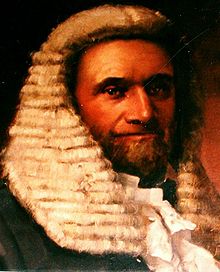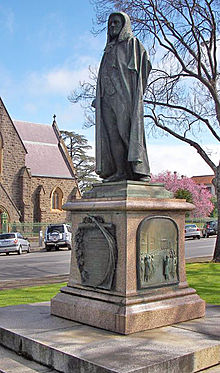Peter Lalor
Lalor was born at Tenakill House, Raheen, in Queen's County (later Laois) in Ireland, which was part of the United Kingdom at the time.
He was the son of Ann (née Dillon) and Patrick "Patt" Lalor, a landowner and supporter of the abolition of tithes, who was a member of the British parliament (MP) in 1832–1835.
Lalor worked briefly on the construction of the Geelong to Melbourne railway, but resigned to take part in the Victorian Gold Rush.
He began mining in the Ovens diggings (Beechworth), then moved to the Eureka Lead at Ballarat where he befriended Duncan Gillies, who later became Premier of Victoria.
[3] Agitation against the requirement to buy a monthly licence to mine for gold began with the Red Ribbon Movement at Bendigo in 1853, and was quickly taken up at Ballarat.
An "insurgent flag" was hoisted on the platform, which consisted of a representation of the Southern Cross constellation on a dark blue background.
Lalor led the miners' opposition against the incompetent and often brutal administration of the goldfields authorities, and was elected to lead the men in the armed uprising after the meeting on Bakery Hill.
A warrant for his arrest on charges of sedition was issued, but he was taken from Ballarat by his supporters and hid in the Young Queen Hotel in South Geelong.
While the victors of Eureka were removing them alive from the stockade, Peter Lalor, the diggers' leader, lay under the pile of slabs in which he had been hidden, bleeding from the wound in his arm.
A musket ball had shattered the bone close to the shoulder, and the few who knew where he was lying saw the blood trickling from beneath the pile of slabs even while the soldiers, keen to capture him, were still in the stockade.
Towards morning he determined to seek assistance from Stephen Cummins, an old friend whom he could trust, and who lived with his wife on Pennyweight Hill.
It was on the early morning of the Monday following the fight that Mrs. Cummins drew her husband's attention to a man walking slowly between the holes on the flat, and said, "That is Peter Lalor; I feel sure of it".
I ran at once across the gully to the Roman Catholic Presbytery and told Father Smyth that Lalor was in my tent badly wounded and in need of surgical assistance.
A man employed about the Presbytery took the severed arm away as soon as the operation was over, and threw it down an abandoned shaft, but by Father Smyth's orders it was recovered later and properly buried.
[5]Due to the political changes caused by the Eureka Stockade, Lalor was elected to the Victorian Legislative Council in November 1855 as one of the two members for the new district of Ballaarat,[6] and remained in that role until March 1856.
Because he was the Eureka hero, his policies were not scrutinised at all before the election and his later voting record as a parliamentarian shows he opposed a bill to introduce full white male suffrage in the colony of Victoria.
[10] Withers and others were puzzled and hurt that the folk hero should prove to be a better fighter for money and political position than for the people's rights.
However, he was consistent in being a risk-taker and, in his later business career, undoubtedly suffered lows as well as highs, at one point narrowly avoiding having to declare bankruptcy.
At the 1877 election, he successfully contested the Legislative Assembly seat of Grant, which he held for almost twelve years, until his death in February 1889.
[7] As the successor to Sir Charles Gavan Duffy, his most effective political post was probably that of Speaker, a position he held from 1880 until 1887, when illness forced his retirement, after which he was awarded a pension of £4,000 by parliament.
Lalor died on Saturday, 9 February 1889 at age 62, four days after his birthday, at his son's home in Richmond, and was buried at the Melbourne General Cemetery.
It has been held successively by senior Labor figures Reg Pollard, Jim Cairns, Barry Jones and Julia Gillard.
[13] Next, he was played by Chips Rafferty in the 1949 British film Eureka Stockade (released in United States of America under the title, Massacre Hill).
[14] He was played by Australian actor Bryan Brown in Eureka Stockade, a two-part television mini-series which aired on the Seven Network in 1984.




